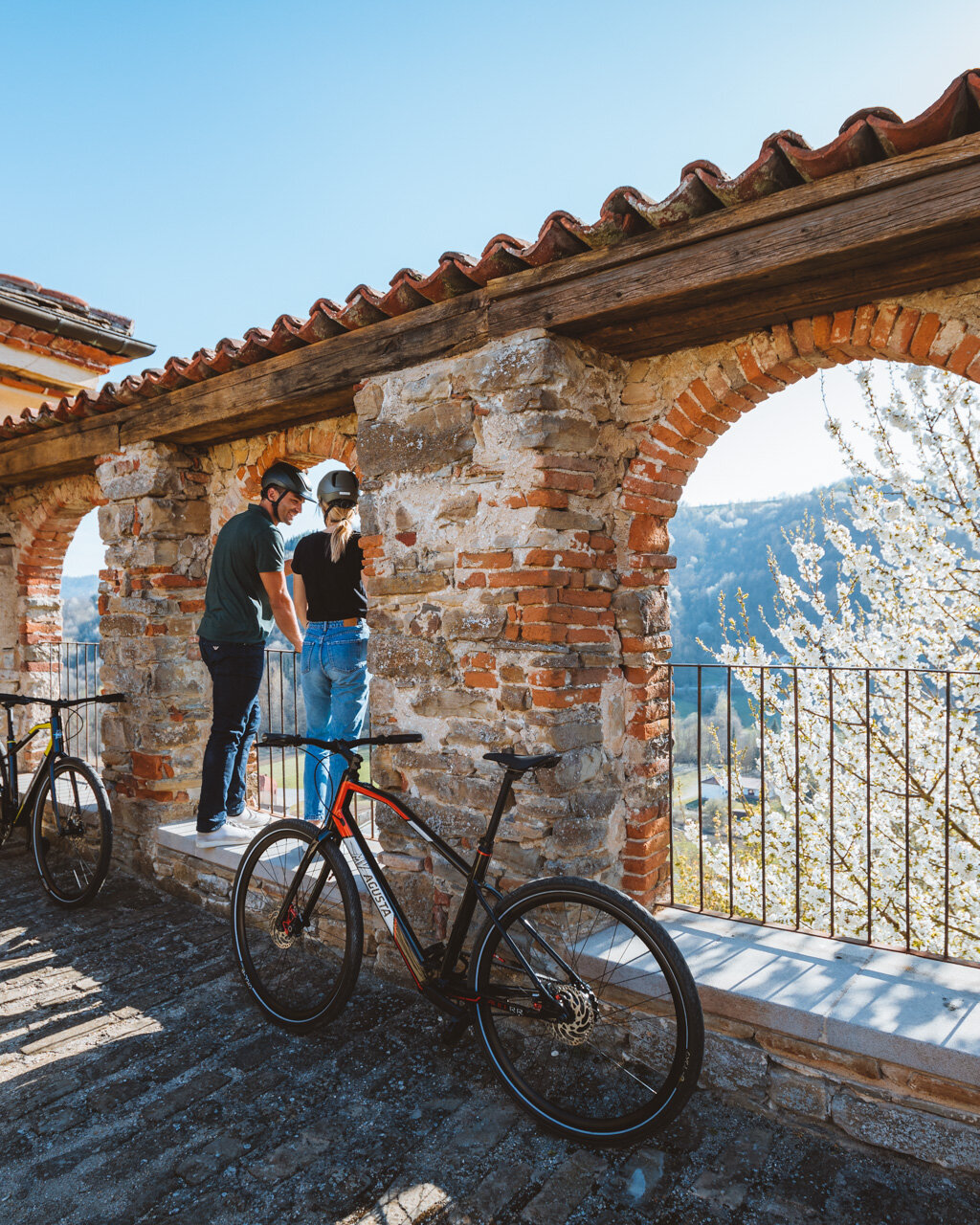You start your walk from the central car park located along the road that crosses the entire protected area, fully equipped with tables and fountain. Once at the entrance you cross the whole car park and at the end take the little road to the right and go downhill ("Rio Rabengo-Fondovalle" green sign). The wide downhill slope gradually descends into the woods until it becomes a path.
- suitable for: kids aged 6 and above
- not suited to strollers (younger kids must be in baby backpack carriers)
- elevation gain: +200 metres overall
- distance: 6 km overall
- estimated time: 2,30 hours
- route type: loop on dirt road, asphalt, footpath
- starting altitude: 220 metres
- minimum altitude: 140 metres
- when: all year round, in winter only in absence of snow
After reaching a ravine you will get to a clearly visible single junction where you have to turn right ("Rocchetta Tanaro 804B" sign) along a wide and flat track that follows the course of a stream (often dry) and leads to a roadblock bar. Continue for a short stretch beyond the bar and you will eventually reach a dirt road.
Continue to the right ("204" sign) following the dirt road for a stretch and then a less wooded stretch. After about 800 metres you must pay attention to a path to the right which is highlighted by an old wooden sign. You cross the stream across a small bridge and start climbing into the deep woods. Towards the end of the climb you have to turn right. At the following junction you keep right again, always uphill, until you reach the top of the ridge where you will find several routes.
Now turn left and go down slightly until you reach the asphalted road. You walk along the asphalted road to the right (past the grassy path when present), thus crossing the hamlet of Sant'Emiliano. Once you leave the houses behind you continue on asphalt. A few steps after an isolated farmhouse, clearly visible to the right, you have to pay attention to a path on your left which is clearly marked by a wooden bar. In some periods of the year this passage could be partly hidden by vegetation. Should this be the case, simply continue a little further and follow the parallel path which is usually cleaner and also marked by a wooden bar. Both paths meet at the same point.
Continue first uphill, then downhill. This stretch follows the Sentiero Natura (Nature pathway) trail, but from here there is no further signage: once you get to the various junctions it is best to always keep to the right, downhill. When you arrive at the third junction please watch out: a signpost points to the Park's old man: a beech tree that is two hundred years old and stands out majestically, recognized as a "monumental tree" by the Piedmont Region. It does not immediately catch your eye, since it is surrounded by many other shrubs, but once next to the sign, you have to look up to the left.
The path that leads to the beech tree is without any exit, so you have to walk back a little and continue until you reach a wide dirt road, which is at the minimum altitude reached by the hike, and you have to follow it to the right ("Casa Parco" sign). When you reach a wooden sign take the small road to the right, uphill, and then take the widest, cleanest, uphill road to the right again (“no horses” sign). The wide trail becomes a narrow footpath and, soon afterwards, you will arrive near the building in the Park which houses a hostel.
If you continue further on you will reach the dirt road where, by turning left, you will shortly arrive at the initial car park.
Notes
Since 1980 the Park has been stretching over the land owned by the Marquises of Incisa who have been present in the territory since the 12th century. The boundaries of the protected area are delimited by two small rivers: the Rabengo (that you almost crossed at the beginning of the hiking tour) and the Ronsinaggio (almost crossed on the way back), the rare crayfish can be found in these waters. Besides the extensive and rich woodland of the park there are forty species of nesting birds that have been identified in there. The Great Beech Tree has the peculiarity of growing at Piedmont’s minimum altitude, 140 metres above sea level (it is usually found higher up), and is evidence of the vast beech forests that used to cover the territory after the great glaciations. It is 25 metres high, while the foliage has a 30 metres diameter and the trunk is 3 metres in circumference at its base.
It is a challenging trail suitable only for those who have a good sense of direction because, regrettably, not all junctions are signposted and the signage is fairly rare. The trail should be avoided at all costs after heavy rainfall as some stretches will turn into real muddy riverbeds.
PLEASE NOTE: Responsibility for the maintenance and practicability of the various trails lies with the municipalities where the routes are located. The Tourist Board, therefore, cannot be held responsible for any inefficiencies, but is willingly available to collect your reports so that they can be forwarded to the authorities concerned.


